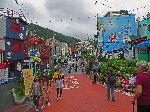Ibike Korea People-to-People Program

 Photo essay: Greater Busan
Photo essay: Greater Busan
Outside of Busan's historic core are numerous district, many
with distinctive attractions.
Points of Interest: Gamcheon Cultural Village, Gwangalli Beach, Beoneosa,
Gamcheon Cultural Village
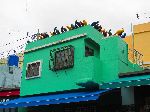
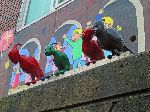
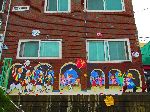
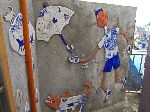
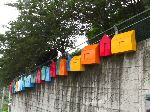

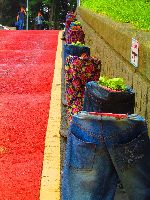 From
Nampo, if you drive up into the hills you can reach Gamcheon Cultural
Village. In the 1940s, only 20 or so houses dotted the hillside, but that
number swelled dramatically at the beginning of the Korean War in 1950.
War refugees fled their homes for the relative safety of Busan, the only
area of the peninsula that remained free from fighting. Within a year,
Busan’s population grew from 880,000 to 1.4 million people, and a half
million homeless refugees needed a place to live and eat. Approximately
4,000 people moved from the crowded port areas surrounding the Jagalchi
Fish Market to nearby Gamcheon, erecting some 800 makeshift homes using
scrap iron, wood and rocks.
From
Nampo, if you drive up into the hills you can reach Gamcheon Cultural
Village. In the 1940s, only 20 or so houses dotted the hillside, but that
number swelled dramatically at the beginning of the Korean War in 1950.
War refugees fled their homes for the relative safety of Busan, the only
area of the peninsula that remained free from fighting. Within a year,
Busan’s population grew from 880,000 to 1.4 million people, and a half
million homeless refugees needed a place to live and eat. Approximately
4,000 people moved from the crowded port areas surrounding the Jagalchi
Fish Market to nearby Gamcheon, erecting some 800 makeshift homes using
scrap iron, wood and rocks.
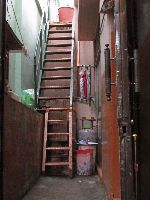
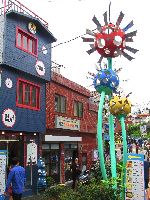 Gamcheon
made progress over the next half century but remained poorer than the rest
of Busan, which busied itself by erecting skyscrapers and high-rises. In
2009, the Ministry of Culture, Sports, and Tourism stepped in with
the Dreaming of Machu Picchu in Busan project. Reparations were made,
artists were hired to paint murals and 10 artworks were installed, some
created with the assistance of the residents. In 2010 the follow-up Miro
Miro project saw the addition of 12 more works, including alley paintings
and path markers perfectly suited to the project as miro means ‘maze’ in
Korean.
Gamcheon
made progress over the next half century but remained poorer than the rest
of Busan, which busied itself by erecting skyscrapers and high-rises. In
2009, the Ministry of Culture, Sports, and Tourism stepped in with
the Dreaming of Machu Picchu in Busan project. Reparations were made,
artists were hired to paint murals and 10 artworks were installed, some
created with the assistance of the residents. In 2010 the follow-up Miro
Miro project saw the addition of 12 more works, including alley paintings
and path markers perfectly suited to the project as miro means ‘maze’ in
Korean.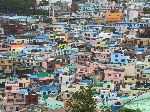
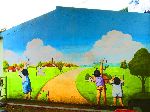 The
house stair-step up the hillside in the colors of mixed candy. Throughout
the public spaces in the community are murals, big sculptures, little
sculptures, decorations and a variety of other art installations created
by residents -- many of them whimsical and almost everything is brightly
colored.. Amongst the outdoor attractions are numerous art shops and
crafts galleries with ceramics, paintings, woodwork, metalwork, textile
crafts, photography and cuteness. Two of the more common subjects are
birds and fish.
The
house stair-step up the hillside in the colors of mixed candy. Throughout
the public spaces in the community are murals, big sculptures, little
sculptures, decorations and a variety of other art installations created
by residents -- many of them whimsical and almost everything is brightly
colored.. Amongst the outdoor attractions are numerous art shops and
crafts galleries with ceramics, paintings, woodwork, metalwork, textile
crafts, photography and cuteness. Two of the more common subjects are
birds and fish.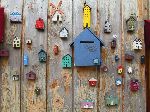
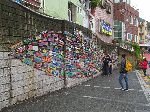
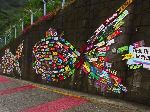
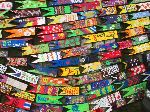
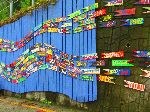
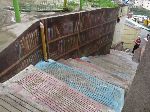
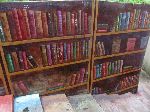 This
retaining wall, along a stairway, has been painted into a book shelf. It
seems to be a tribute to books, the places they take us and the lessons
that stories impart.
This
retaining wall, along a stairway, has been painted into a book shelf. It
seems to be a tribute to books, the places they take us and the lessons
that stories impart.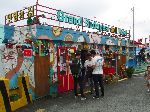
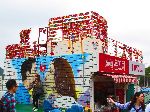
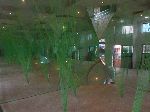
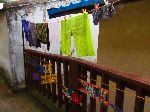 From
left to right: the Grand Budapest Doll Hotel, I Love You Shop (with rails
of love-locks on the roof), a small room made to look large with mirrors
and decorated this clusters of green string, and the last image, with a
decorated fence and laundry out to dry, is a mixture of life and art.
From
left to right: the Grand Budapest Doll Hotel, I Love You Shop (with rails
of love-locks on the roof), a small room made to look large with mirrors
and decorated this clusters of green string, and the last image, with a
decorated fence and laundry out to dry, is a mixture of life and art.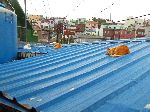
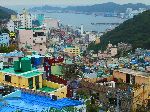
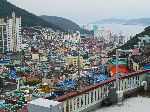 While
the concept was created in conjunction with the community, and with the
objective of attracting tourists, there are rumor of residents being
resentful of what they wished for. The single road leading up the hill is
congested in both directions for long hours, and it is hard to take step
on the main road without being in someone's picture. Somehow the cats have
gotten it figured out (left)
While
the concept was created in conjunction with the community, and with the
objective of attracting tourists, there are rumor of residents being
resentful of what they wished for. The single road leading up the hill is
congested in both directions for long hours, and it is hard to take step
on the main road without being in someone's picture. Somehow the cats have
gotten it figured out (left)At the end of the day, the outward view is as nice as the inward kitsch.
Gwangan
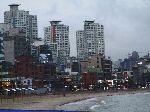
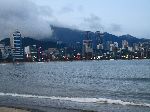
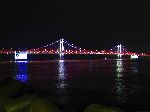 One
would go to Gwangan to shop, hang in a coffee shop, drink an IPA, play on
the beach or watch the light show on the Gwangandaegyo at night.
One
would go to Gwangan to shop, hang in a coffee shop, drink an IPA, play on
the beach or watch the light show on the Gwangandaegyo at night.To maintain Gwangalli Beach the government buys sand and dumps it on the beach every year to replace that which has been washed away by waves.
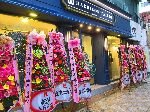
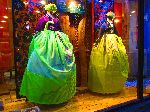 Many
of the shops in Gwangan cater to refined tastes. You might say that about
the brewery as well, being one of only a handful of bars where you can get
an IPA on tap. One the night we were there the majority of the customers
were Westerners, and the majority of these were Millennials in Busan to
teach English.
Many
of the shops in Gwangan cater to refined tastes. You might say that about
the brewery as well, being one of only a handful of bars where you can get
an IPA on tap. One the night we were there the majority of the customers
were Westerners, and the majority of these were Millennials in Busan to
teach English.The hanbok in the window of the hanbok shop were bigger and more tailored than usual, and the fabic had hand painted designs.
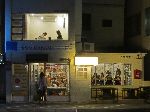
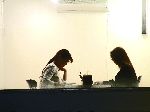
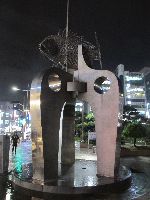 It
appears that besides a great view and evocative name, the 오랜지바다 (Orange
Sea) coffee shop's entire customer base is female and under 25 -- maybe
younger than 20 -- and heavy cell phone users (left). At least tonight it
wasn't so much about the view.
It
appears that besides a great view and evocative name, the 오랜지바다 (Orange
Sea) coffee shop's entire customer base is female and under 25 -- maybe
younger than 20 -- and heavy cell phone users (left). At least tonight it
wasn't so much about the view.The shop also displayed a banner for and event, 정명란 DREAM, that ran for two weeks in September. My guess is it is for an art exhibit.
Across the road is the beach, bay, fish market and a fish sculpture.
Beomeosa
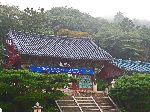
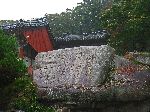
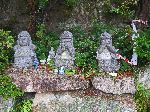 Beomeosa
myth: "There is a well on the top of Mt. Geumjeongsan and the water of
that well is gold. The golden fish in the well rode the colorful clouds
and came down from the sky. This is why the mountain is named Geumsaem
(gold well) and the temple is named 'fish from heaven'."
Beomeosa
myth: "There is a well on the top of Mt. Geumjeongsan and the water of
that well is gold. The golden fish in the well rode the colorful clouds
and came down from the sky. This is why the mountain is named Geumsaem
(gold well) and the temple is named 'fish from heaven'." 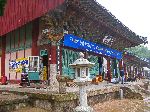
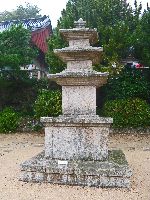
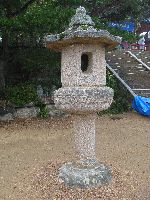
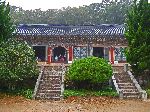
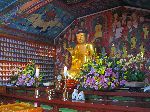 In
its original configuration of the Palang-Dokseong-Nahanjeon, from 1713,
the Palsangjeon (temple) was on the left and the Nahanjeon (temple) on the
right, with the Cheontaemun (gate) in the center. After reconstruction in
1905, the Palsangjeon and Nahanjeon remained true to their original
design. The Dokseongjeon (temple) replaced the Cheontaemun, with a more
decorative form, including a unique arch-style doorframe, an ivy-shaped
In
its original configuration of the Palang-Dokseong-Nahanjeon, from 1713,
the Palsangjeon (temple) was on the left and the Nahanjeon (temple) on the
right, with the Cheontaemun (gate) in the center. After reconstruction in
1905, the Palsangjeon and Nahanjeon remained true to their original
design. The Dokseongjeon (temple) replaced the Cheontaemun, with a more
decorative form, including a unique arch-style doorframe, an ivy-shaped
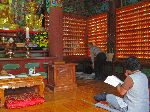 pattern on the triangular part of the wall and latticed doors. The
Palang-Dokseong-Nahanjeon is considered of cultural importance because it
retains most of the architectural style of early 1700s and enshrines three
Buddhist sanctums in one place, and incorporated exceptionally artistic
design and inscription methods in the Dokseongjeon.
pattern on the triangular part of the wall and latticed doors. The
Palang-Dokseong-Nahanjeon is considered of cultural importance because it
retains most of the architectural style of early 1700s and enshrines three
Buddhist sanctums in one place, and incorporated exceptionally artistic
design and inscription methods in the Dokseongjeon.
 Please
contact us if you would like to be added to
Ibike's mailing list or have questions, comments, corrections or criticism. (Also, please let us know how you learned about us and
found this site.) Privacy policy.
Please
contact us if you would like to be added to
Ibike's mailing list or have questions, comments, corrections or criticism. (Also, please let us know how you learned about us and
found this site.) Privacy policy.
![]() IBF Homepage
IBF Homepage ![]() Ibike Programs
Ibike Programs
![]() Ibike Schedule
Ibike Schedule
![]() Search
Search
